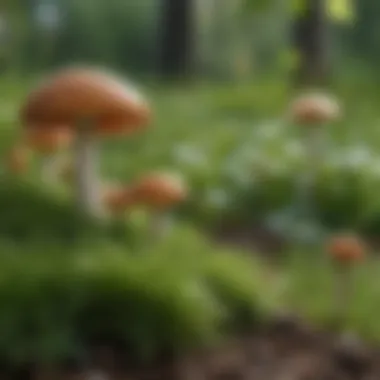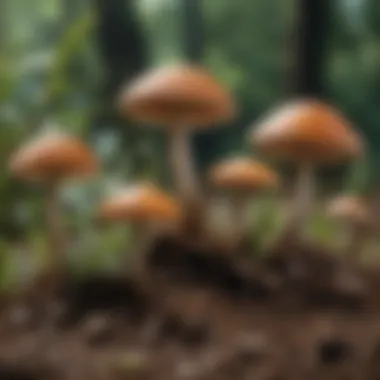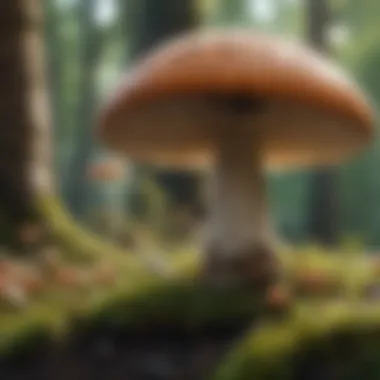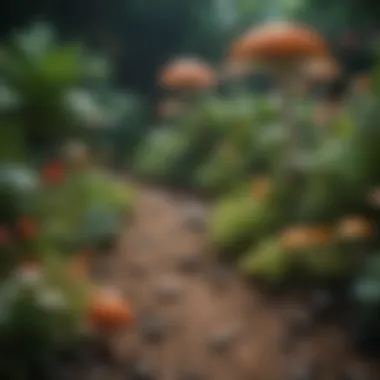Effective Strategies for Managing Fungal Growth in Your Yard


Intro
Mushrooms can be both intriguing and problematic to many homeowners and gardeners. While they contribute to the ecosystem, their sudden appearance can cause concern. Understanding how and why mushrooms thrive is essential for anyone looking to maintain a healthy yard. This knowledge not only allows for the effective management of fungal growth but also ensures the ecological balance of your garden remains intact.
In this article, we will explore various strategies to identify, manage, and eliminate mushrooms from your outdoor spaces. We will also examine preventative methods that promote a healthy lawn environment.
Fascinating Facts About Mushrooms
Mushrooms belong to a group of organisms known as fungi. Here are some interesting facts:
- Variety: There are over 10,000 known species of mushrooms. Each has its unique characteristics and habitats.
- Reproduction: Mushrooms reproduce via spores, which can spread through wind, water, or even animals.
- Ecological Role: They play a vital role in decomposition, breaking down organic matter and recycling nutrients within the ecosystem.
Behavior and Habitat
Mushrooms can emerge in various environments. They often thrive in damp and shaded areas, making certain parts of gardens ideal for their growth. Here’s what to consider:
- Natural Habitats: Mushrooms prefer dark, moist conditions. Look for them near rotting wood, mulch, or areas with a history of dampness.
- Soil Quality: Well-aerated soil that retains moisture can encourage mushroom growth. Poor drainage or thick underbrush can worsen the situation.
Recent Scientific Discoveries
Research into fungi has advanced significantly in the last few years. Some notable findings include:
- Symbiotic Relationships: Various types of mushrooms form beneficial relationships with plants, enhancing nutrient absorption.
- Bioremediation Potential: Certain fungi can help break down pollutants in the soil, showcasing their importance in environmental management.
Cultural Significance
Mushrooms have been woven into the fabric of human culture for centuries. They appear in various aspects:
- Folklore and Mythology: Many cultures regard certain mushrooms as symbols of transformation or mystery. Their association with the supernatural is noteworthy.
- Art and Literature Influence: Notably featured in various forms of art, mushrooms often symbolize growth, decay, and the cyclical nature of life.
In summary, mushrooms present a unique challenge, but understanding their behavior, habitat, and significance can empower homeowners to manage them effectively. With the right strategies, it is possible to maintain a healthy, mushroom-free garden environment.
Understanding Mushroom Growth
Understanding the intricacies of mushroom growth is essential for any homeowner or gardener facing the challenge of fungal proliferation in their yard. Mushrooms, while often perceived as harmless, can indicate underlying soil issues or excess moisture. Recognizing why and how these structures develop can significantly inform effective management strategies.
Mushrooms are the fruiting bodies of fungi; their presence is often symptomatic of decay, nutrient cycling, or an imbalance in soil health. The identification of mushroom types and their biological requirements can help in developing targeted removal and prevention strategies. Additionally, understanding these growth patterns aids in maintaining a healthy and balanced garden ecosystem, making your outdoor space more enjoyable.
The Biology of Mushrooms
Mushrooms belong to a diverse group of organisms known as fungi. They reproduce through spores, which can develop into new fungal networks called mycelium. This mycelium exists primarily underground or within decaying organic matter.
The life cycle of a mushroom includes several stages:
- Spore Germination: Spores land in a suitable environment and germinate.
- Mycelium Development: The germinated spores develop into mycelium, which spreads throughout the substrate.
- Fruiting Body Formation: Under appropriate conditions, the mycelium produces a mushroom.
Mushrooms serve several ecological roles, including decomposing organic material and forming symbiotic relationships with plants. Knowing their biology provides insight into their persistence in grassy areas and gardens.
Common Types of Lawn Mushrooms
While there are many species, some types of mushrooms are commonly found in lawns. Each type has unique characteristics and growth conditions. Common examples include:
- Champignon (Agaricus bisporus): Usually found in rich, composted soil. While edible, caution is necessary, as misidentification could lead to poisonous varieties.
- Shaggy Mane (Coprinus comatus): Recognizable by its long, white, shaggy cap, often appearing in clusters.
- Fly Agaric (Amanita muscaria): Famous for its bright red cap with white spots. This mushroom is toxic.


Identifying these mushrooms can help determine if they present a risk to pets or children. Educating oneself about the local species can empower effective management decisions.
Conditions Favoring Mushroom Growth
Mushrooms thrive under specific environmental conditions. Understanding these factors can help in mitigating unwanted growth. Key conditions include:
- Excess Moisture: Wet soil or high humidity levels can promote spore germination.
- Organic Matter: Lawns rich in decaying plant material or compost are more likely to support mushroom development.
- Poor Drainage: Areas where water accumulates can create an ideal habitat for fungi.
It is essential to monitor these environmental elements in your yard to help reduce the likelihood of mushroom overgrowth. Adjusting soil conditions, managing moisture levels, and removing excessive organic materials can promote a healthier garden environment.
Identifying Fungal Growth
Identifying fungal growth in your yard is a vital step for homeowners aiming to maintain a healthy outdoor space. Recognizing the signs of mushroom overgrowth can help prevent potential harm to your plants, soil quality, and the overall aesthetic of your garden. Many people might overlook the initial appearance of mushrooms, assuming they are harmless. However, understanding their presence and implications plays a significant role in effective management.
Signs of Mushroom Overgrowth
Mushrooms can appear in a variety of shapes, sizes, and colors. The following signs indicate possible overgrowth:
- Visible Mushrooms: The most obvious sign. If you see clusters or single mushrooms sprouting, it’s a clear indication of fungal activity.
- Mold or Mildew: Often accompanies mushroom growth, particularly in damp areas. This can show that the soil is retaining more moisture than advisable.
- Unpleasant Odor: A musty or rotting smell can signal decaying organic matter below the soil surface, which creates an ideal environment for mushrooms.
- Dying Plants: If surrounding plants exhibit wilting or discoloration, this may suggest that mushrooms are absorbing vital nutrients, affecting the health of nearby flora.
Recognizing these signs early allows for timely intervention, which is crucial in preventing further spread and damage in your yard.
Environmental Factors to Consider
Understanding the environmental factors contributing to fungal growth is essential in managing mushrooms effectively. Some key elements to consider include:
- Soil Moisture: High moisture levels create a perfect habitat for mushrooms. Heavy rain or poor drainage can increase the likelihood of overgrowth.
- Shade: Areas with limited sunlight often maintain damp conditions, which support fungal growth. Trees and shrubs offer shade and retain moisture in the soil.
- Organic Material: The presence of decomposing leaves, wood, or mulch provides nutrient-rich conditions for fungi. Regular yard maintenance can help control this factor.
- Soil pH: Acidic soils tend to promote mushroom growth. Testing soil pH can provide insight into adjustments needed to discourage mushrooms.
Recognizing these factors can go a long way in preemptively addressing mushroom problems before they escalate. Managing environmental conditions not only aids in controlling fungal growth but also promotes a healthier lawn overall.
In summary, understanding the signs and environmental factors of fungal growth is invaluable. With this knowledge, proper management strategies can be applied to maintain a vibrant and healthy yard.
Strategies for Removal
Managing fungal growth is crucial for maintaining a healthy yard. This section covers various methods for mushroom removal, ensuring you can tackle the problem effectively and maintain the horticultural balance of your garden. The strategies outlined here range from hands-on techniques to chemical and natural solutions, addressing various needs and preferences.
Manual Removal Techniques
Using Gloves to Protect Your Hands
Using gloves is an essential step in manual mushroom removal. It protects the skin from potential irritants and allergens found in mushrooms. Gloves made from nitrile or latex are effective choices. These materials offer a barrier between your hands and the fungi, reducing the risk of contact dermatitis or infections.
The key characteristic of wearing gloves is the added safety they provide. Many people might underestimate the potential hazards involved in handling mushrooms, especially if they are not sure about the exact type. Thus, the presence of gloves enhances the overall safety while handling these organisms.
However, a minor disadvantage is that some gloves might affect dexterity. The thicker material may reduce the feel when gripping the mushrooms, but the benefits generally outweigh this concern.
Proper Disposal Methods
Proper disposal methods for removed mushrooms are vital for effective management. Simply discarding them in the compost heap may not be beneficial, as some mushrooms can reproduce from fragments left behind. Instead, it’s recommended to place them in sealed bags and dispose of them in the trash. This practice minimizes the spread of spores.
The key strength of proper disposal methods is preventing the reinfestation of mushrooms in your yard. By ensuring that all removed parts are eliminated correctly, you are essentially breaking the growth cycle. This strategy promotes a healthier lawn and reduces the likelihood of future fungal outbreaks.
An important factor to consider is the environmental impact of your disposal method. Burning mushroom debris might seem effective, but it can produce harmful smoke. The unique feature of using sealed plastic bags is that it’s straightforward and eco-friendy when done right, even if it might lead to a slight increase in landfill waste.


Chemical Solutions
Types of Fungicides
Fungicides are a common commercial solution for controlling mushrooms in your yard. They are chemical substances designed specifically to inhibit fungal growth. Various fungicides are available, with some targeting specific types of fungi while others offer broad-spectrum protection.
The main characteristic of fungicides is their effectiveness against existing fungal colonies. They work by disrupting the reproductive cycle or destroying fungal structures. This makes them a beneficial choice for immediate control of overwhelming mushroom growth, especially under conducive conditions.
However, a unique feature is that not all fungicides are safe for all plants or human interaction. Some chemicals may cause harm if they touch desirable vegetation or if inhaled. So, reading product labels is very important for effective and safe application.
Application Guidelines
Applying fungicides correctly is crucial to achieving the desired results. Follow the instructions provided by manufacturers for safe and effective use. This involves understanding the right dosages, application intervals, and necessary safety precautions.
The importance of application guidelines cannot be overstated. They ensure that the product performs as intended while also protecting the surrounding environment and plant life. The guidelines include specifics like optimal weather conditions for application, which can prevent runoff and enhance absorption.
One key aspect of these guidelines is timing. Fungicides are often more effective when applied early in the mushroom life cycle. However, there could be disadvantages, such as the potential for resistance development in certain fungi if misused, which can make a future fungal invasion even more problematic.
Natural Alternatives
Vinegar and Water Solution
Vinegar acts as a natural fungicide and can be effective against some mushrooms. A mixture of vinegar and water can deter their growth when sprayed directly on affected areas. The acetic acid in vinegar alters the pH level of surrounding soil, creating an inhospitable environment for fungi.
The significant characteristic of this method is its safety for humans, pets, and plants, making it a popular choice for many. It is also readily available and inexpensive. The unique feature of vinegar is its multipurpose usage, allowing you to utilize it for various household cleaning tasks beyond fungal management.
However, a disadvantage is that vinegar may not be effective against all mushroom species. It generally works better on softer, more delicate mushrooms, leaving tougher varieties resistant.
Baking Soda Method
Baking soda is another natural alternative for controlling mushroom growth. When mixed with water and sprayed on the affected area, it can inhibit fungal growth due to its alkaline nature. This method is effective and also environmentally friendly.
The appealing aspect of this method is that baking soda is non-toxic and safe for plants. It is readily available in most homes, adding to its accessibility. The unique benefit of using baking soda is that it can help control odors as well, tackling any accompanying issues related to fungi.
However, one disadvantage is that multiple applications may be necessary. The effects can diminish quickly with heavy rain or watering, so consistency is key to achieving satisfactory results.
Preventative Measures
Preventing mushroom growth in your yard is vital for maintaining the aesthetic and health of your garden. Effective preventative measures can reduce the likelihood of fungal proliferation. This not only safeguards the appearance of the landscape but also contributes to the overall soil vitality and ecosystem balance. Addressing this issue proactively can save time and resources compared to dealing with a mushroom overgrowth situation later.
Maintaining Soil Health
Healthy soil is the foundation of a thriving garden. Regularly testing the soil is paramount. This includes checking pH levels, nutrient content, and organic matter. Amending soil with organic matter such as compost can improve structure and fertility. Healthy soil promotes strong root systems that compete with fungi for nutrients. Furthermore, incorporating proper drainage techniques can prevent waterlogging, which fosters fungal growth. Keeping soil aerated also helps reduce excessive moisture, thus inhibiting conditions favorable for mushrooms.
Proper Watering Techniques
Watering your garden appropriately is crucial in preventing excess fungal growth. It is important to adopt a schedule that waters deeply but infrequently. Shallow watering can lead to surface moisture, which mushrooms thrive on. Consider using soaker hoses or drip irrigation to deliver water directly to the roots. This technique helps keep the surface dry while ensuring that the plant roots receive necessary hydration. Observing the weather and adapting your watering schedule accordingly will benefit all plants in your yard while reducing fungal risks.
Enhancing Sunlight Exposure
Increasing sunlight in your garden is also an effective strategy to mitigate mushroom growth. Fungi prefer shaded and damp conditions. Trimming overgrown trees or shrubs to allow more light into your yard can help. This not only deters mushrooms but also promotes healthy plant growth. If certain areas receive minimal light, consider planting shade-tolerant ground cover that can absorb moisture, leaving less available for fungi. A well-lit garden is less hospitable to mushrooms and ensures optimal growth conditions for your plants.
Key Point: A combination of proper soil health, effective watering techniques, and maximizing sunlight exposure can significantly reduce the likelihood of mushroom appearance in your yard.


Cultural Impact of Fungi
Understanding the cultural impact of fungi is vital for both gardeners and those interested in ecology. While many may view fungi, particularly mushrooms, as a nuisance in gardens, they play significant roles in various ecosystems. Recognizing these roles can lead to better management strategies and promote a healthier environment.
Fungi in Ecosystems
Fungi carry out essential functions in ecosystems. They are involved in the decomposition process, breaking down dead organic matter and recycling nutrients back into the soil. This assists plant life by increasing soil fertility and promoting plant health. Additionally, fungi form symbiotic relationships with various plants through mycorrhizal associations. In these partnerships, fungi provide plants with increased access to water and nutrients while receiving carbohydrates in return. This interaction is crucial for the survival of many plants.
“Fungi are the recyclers of nature, turning waste into life-sustaining resources.”
Understanding these roles helps in managing mushroom growth. Rather than seeing mushrooms solely as unwelcome intruders, efforts can focus on enhancing the beneficial aspects of fungi. Providing a balanced ecosystem encourages healthy fungi growth, which can help maintain soil health and biodiversity in yards.
Mushrooms and Wildlife
Mushrooms also influence local wildlife. Different species of mushrooms offer food sources for a variety of animals, including insects, birds, and mammals. The presence of mushrooms can indicate a healthy ecosystem, as they showcase a habitat's biodiversity.
In contrast, the overgrowth of undesirable mushrooms could potentially attract pests that may harm vegetable gardens or ornamental plants. Therefore, recognizing the relationship between mushrooms and local wildlife is essential for keeping a balanced yard.
In summary, while managing fungal growth is important, understanding the cultural impact of fungi enriches the approach to yard care. Rather than eliminating mushrooms entirely, consider fostering an environment where beneficial fungi can thrive, supporting both plant health and local wildlife.
When to Seek Professional Help
Understanding when to call in professionals for mushroom control is critical for maintaining the health of your yard. Although DIY techniques can be effective, certain situations require expert intervention. Factors such as the scale of the fungal infestation, the types of mushrooms present, and potential underlying issues in your soil condition can make professional help necessary. Seeking an expert ensures that you are addressing the root of the problem and taking the right measures to maintain the ecological balance of your outdoor space.
Signs You Need Expert Assistance
There are several indicators that can suggest it might be time to seek help from professionals:
- Persistent Growth: If mushrooms continue to proliferate despite your removal efforts, this might indicate underlying issues in your soil or environment that require expert analysis.
- Toxic Varieties: The presence of toxic mushroom species poses a severe risk to children and pets. Identifying the type can best be addressed by an expert.
- Structural Concerns: If you suspect that fungal growth is affecting the roots of plants or any structure, expert assessment can prevent further damage.
- Health Risks: Allergies or respiratory issues triggered by fungal bodies may necessitate professional cleaning and assessment of the area.
Recognizing these signs early can save you time, money, and further risk.
Choosing the Right Service Provider
Selecting a qualified expert to assist in mushroom management involves careful consideration. Here are some guidelines to help you find the right service:
- Qualifications: Look for professionals with proper certifications in horticulture or environmental science. This will ensure they have a solid understanding of fungal biology and ecology.
- Experience: Prioritize providers who have demonstrable experience in managing fungal growth specifically. References or client testimonials can provide insight into their effectiveness.
- Environmental Consideration: Choose a provider who understands the importance of ecological balance. Their methods should prioritize sustainability and avoid harmful chemicals.
- Comprehensive Services: A good provider should offer more than just removal; they should also offer advice on preventing future growth and bolstering your yard's overall health.
By adhering to these criteria, you can make an informed decision that ensures the effective management of fungal growth while supporting the overall health of your yard.
Epilogue
In managing fungal growth, particularly mushrooms in your yard, comprehending the approaches is essential for both aesthetic and ecological reasons. This article provided a holistic view of identifying, removing, and preventing mushroom overgrowth. By acknowledging the underlying causes, you can better harness practical methods tailored to your specific yard environment.
Summarizing Effective Approaches
Effective management begins with understanding the biology of mushrooms and the environmental conditions that favor their growth. Recognizing the signs early, such as discoloration in grass or soil anomalies, allows for timely intervention. Manual removal can be effective, but when larger infestations occur, considering chemical solutions or natural alternatives may be necessary.
A clear focus on maintaining soil health and adjusting watering techniques also plays a vital role. The balance between moisture retention and drainage should not be overlooked. Educating yourself on local fungi can facilitate correct identification, helping to choose the best control strategy. Practical methods and consistent monitoring will yield a healthier lawn in the long run.
Encouraging a Balanced Yard Ecosystem
Maintaining a balanced yard ecosystem involves understanding the intricacies of local biodiversity. Mushroom growth does play a role in enhancing soil fertility and supporting various organisms. It is crucial to remember that fungi are part of the ecosystem, serving as decomposers, thus contributing to a balanced environment.
To encourage this balance:
- Assess soil health regularly.
- Allow for appropriate sunlight exposure.
- Implement efficient watering techniques that do not favor fungal growth but support desired plant life.







